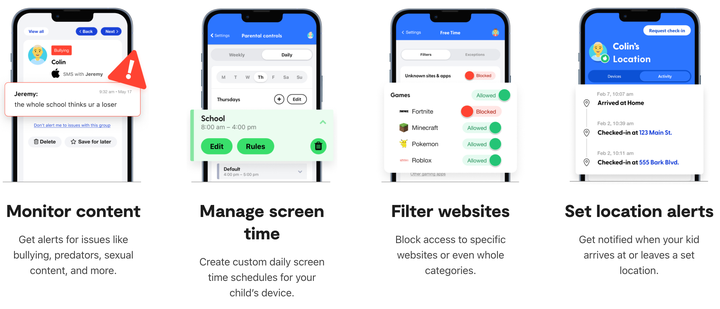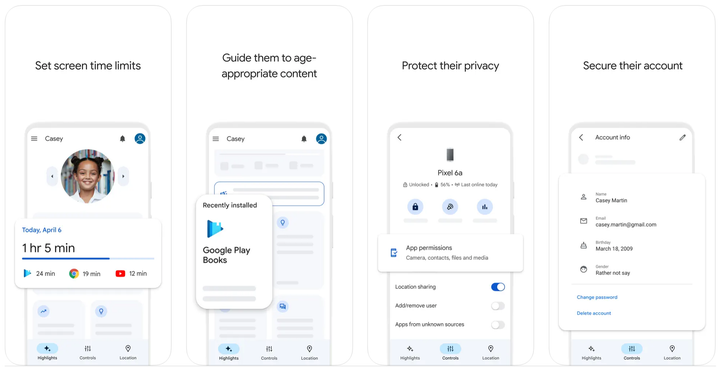It can be so dangerous out there.
The internet is a terrifying place to send your kids. Predators prey on youth, pictures never truly disappear, trolling bigots ambush newsfeeds and decade-old tweets can haunt future careers. It’s not as if we can completely take our children off the grid until they graduate high school, so how do we keep them safe?
Until a child is in their mid-20s, their prefrontal cortex, the part of the brain that helps them plan and control impulses, isn’t fully developed. “Part of the parent’s obligation is to be in place of that judgment center to help the child make better choices,” said Adam Pletter, a child psychologist who runs the iParent 101 parenting and technology workshop.
He believes spying is very different than monitoring and that “supervising and mentoring” is what parents should aim for with their children’s online activity, “just like any other parenting concern, in hopes of safeguarding and teaching their children to better self-regulate into their adolescence and young adulthood.”
This monitoring should start “as early as you can, because it’s a mess to put the toothpaste back in the tube,” Pletter said.
While the FBI doesn’t endorse any particular monitoring apps, it does encourage parents “to become familiar with all of the devices their children have access to, computers, tablets and phones,” said Amanda Videll, public affairs officer for FBI Jacksonville.
“The best thing is be involved,” she added. “There is no substitution for direct and consistent engagement with your child. Parents should have ongoing conversations with youth of all ages to encourage responsible online behaviors and warn them of the risks of communicating with people they do not know personally.”
If you do catch your kid doing something inappropriate, remind them that mistakes are “part of how you grow,” said Diana Graber, author of “Raising Humans in a Digital World: Helping Kids Build a Healthy Relationship With Technology.”
She recommends keeping kids off apps and social media as long as possible, and that all choices about the internet and apps being used should be openly discussed with kids. “Sit the family down together, make decisions on what’s appropriate for that kid, what you trust them with, what you still want them to have some restrictions on,” she said. “Choose restrictions together. Revisit in a month.”
The goal is to trust kids as much as possible and keep the conversation open, so if they run across something disturbing or inappropriate, they know they can talk to you.
Here are six apps to support you as a parent in monitoring your kids online.
1. Bark

Bark is a popular choice that claims to have detected over 629,000 severe harm situations and 2.6 million severe bullying situations. Bark allows parents to block websites and apps, manage screen time, get location updates, and monitor text messages, video sites, emails, and over 30 social networks. The app screens for everything from inappropriate conversations with strangers to signs of depression or suicidal thoughts, shooting alerts immediately to parents if anything concerning is detected. There is even a Samsung Bark phone with built-in Bark monitoring and real time location tracking.
Cost: Free seven-day trial, then $5 for the younger kid version, $14 for premium. Plans include unlimited family members. The phone-included plan is $49 a month.
2. Qustodio
Qustodio allows parents to set limits on kids’ overall daily screen time, like many of the other apps on this list, but it also allows them to set limits for individual apps as well as block out numerous time periods each day, such as homework time, dinnertime and bedtime. The easy-to-use app blocks inappropriate content, monitors what kids are looking at, and offers location tracking and notifications when kids arrive at set locations. It also allows parents to view contacts, calls, and messages, and sends them daily, weekly, and monthly activity reports. It can be used across computers, phones and tablets with Android or iOS operating systems.
Cost: Free for one device, then starts at $54.95 per year for five devices. You can get a free three-day trial.
3. Find My Kids
If you aren’t interested in monitoring your kid’s internet usage, but want to know your kids are safe physically, this app zeroes in on location tracking, monitoring your child’s location and shooting you notifications when they reach set landmarks, and even allows you to listen in on your child’s surroundings. (This feature isn’t available on iPhones.) If your child is in danger and they can’t call you, they can send you an SOS signal, giving you their exact location while their phone automatically begins recording audio. If your child doesn’t have a phone, there’s a Find My Kids watch available.
Cost: For one device: $2.99 a month or $33.98 a year ($16.99 at the time of writing because of promotion). For up to three devices: $42.99 a year. Minutes for live listening function cost $1 per 30 minutes, $4.49 for 180 minutes, $14.99 for unlimited each month.

This is a free and easy-to-use app that allows parents to monitor app usage, set limits on screen time, and track kids’ locations. Using Google Maps along with the app will allow you to be notified when your children reach set destinations. Although parents can’t restrict screen time for individual apps, they can block individual apps. Google Family Link also allows parents to manage in-app purchases so kids can’t go on a spending spree. Once a child reaches 13, they need to consent to continue to be monitored with this app.
Cost: Free
The free Kaspersky plan is a decent option if you don’t need all the features. The free plan includes web and app content filtering, YouTube filtering, app usage control, and screen time limits. The paid plan includes GPS location tracking, a battery tracker and real-time alerts for if kids go to inappropriate sites or wander away from set locations. Kaspersky Safe Kids works across platforms and can be used on unlimited devices.
Cost: Free or $14.99 per month for premium.
6. Net Nanny
Although Net Nanny doesn’t monitor phone calls or text messages, it shines when it comes to real-time alerts if a child searches for blocked content or porn, suicide, weapons and drug-related content. It also “masks” profanity on websites, censoring words instead of blocking entire sites, so kids can do research for homework without having sites restricted because of a curse word in the comments section. In addition to that, it has many of the features the other programs have, including location tracking and screen time management.
Cost: $39.99-$129.99 per year, depending on the number of devices monitored and promotions running
No matter how much you choose to monitor your kids, they will make mistakes, and it’s important to remember that’s a step in their growth. Graber said you want them to know they can come to you and that you will say something like, “I have been there. Let’s not do it again. Here’s what you can do differently.
Credit: Source link